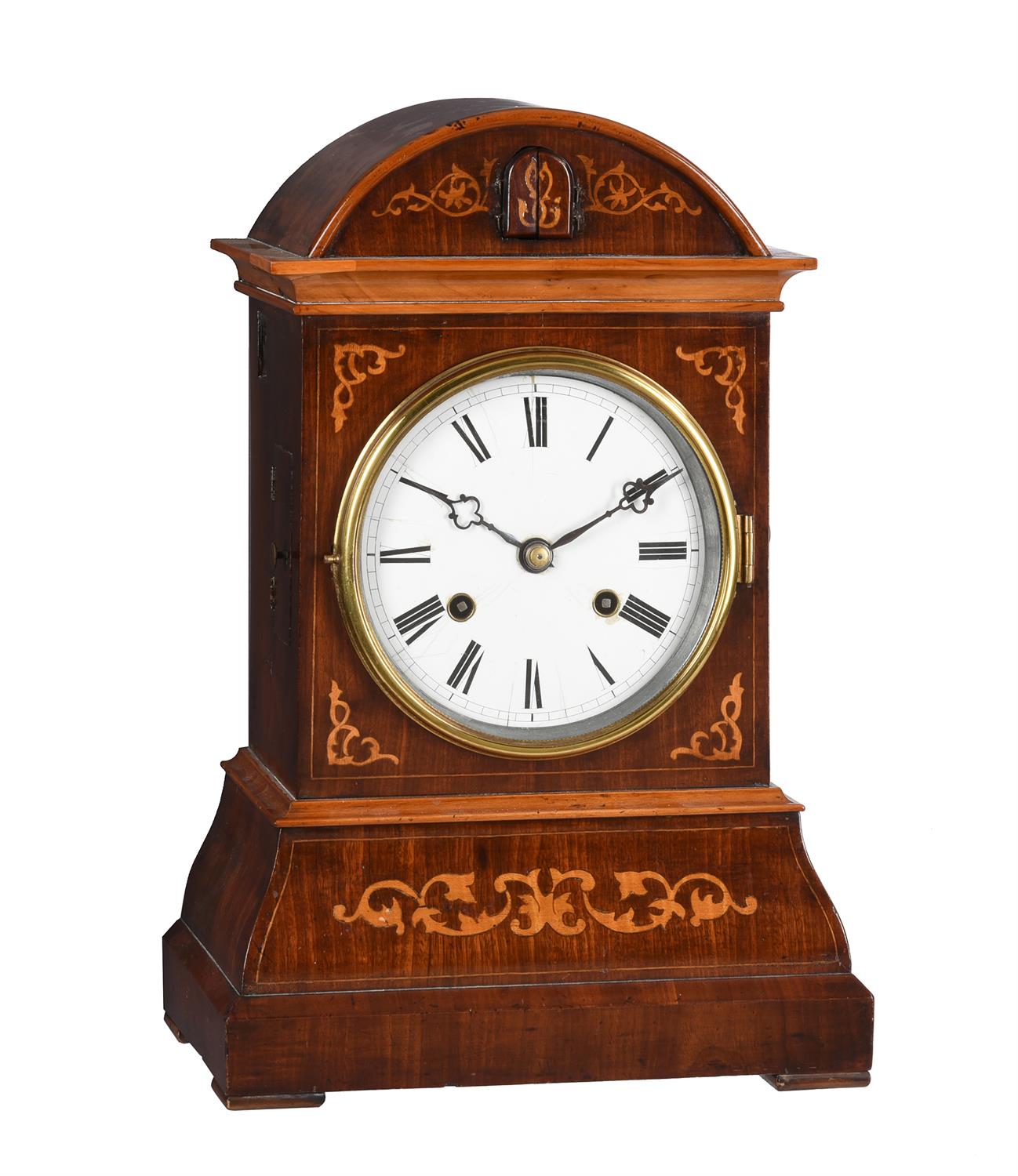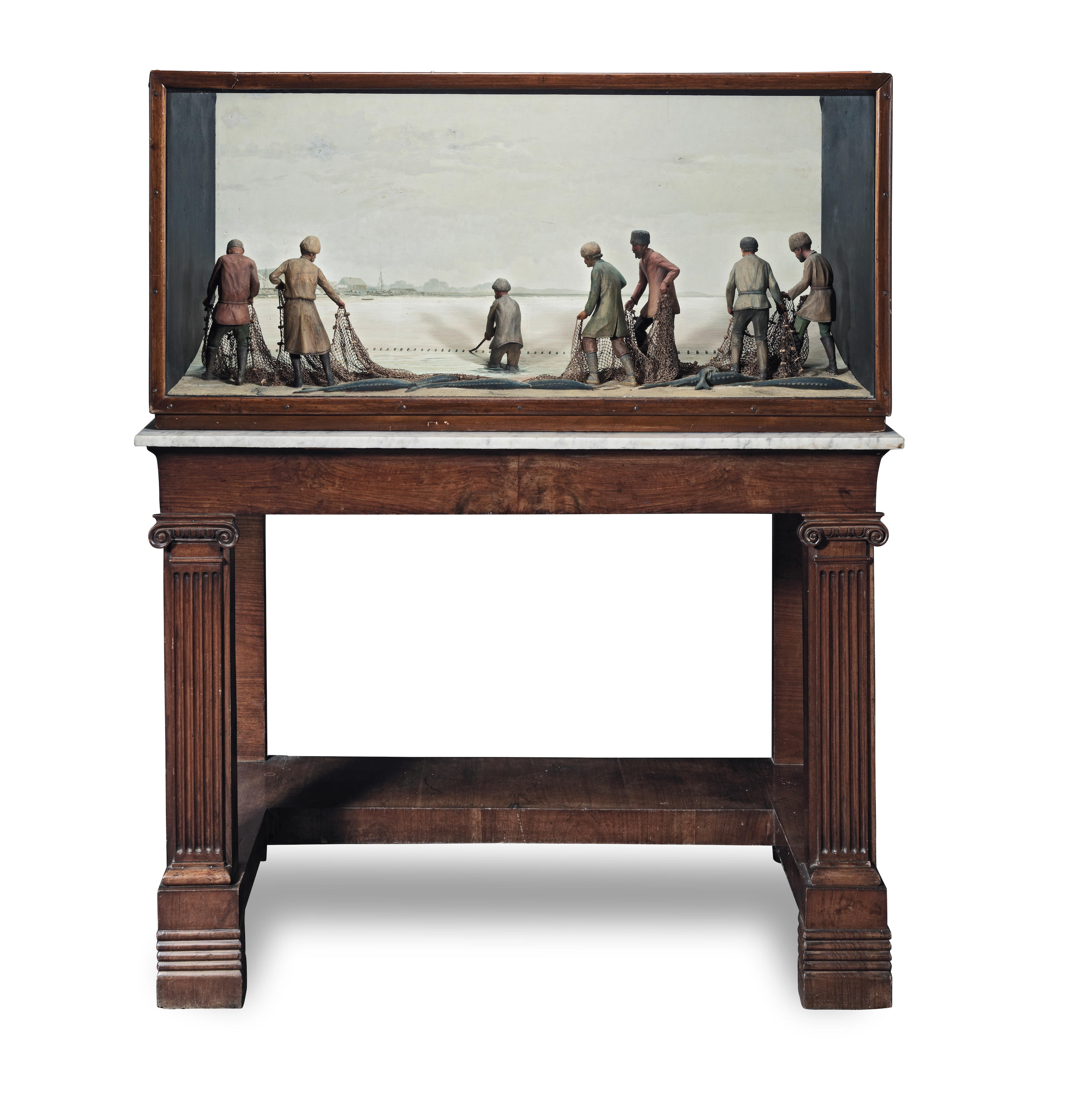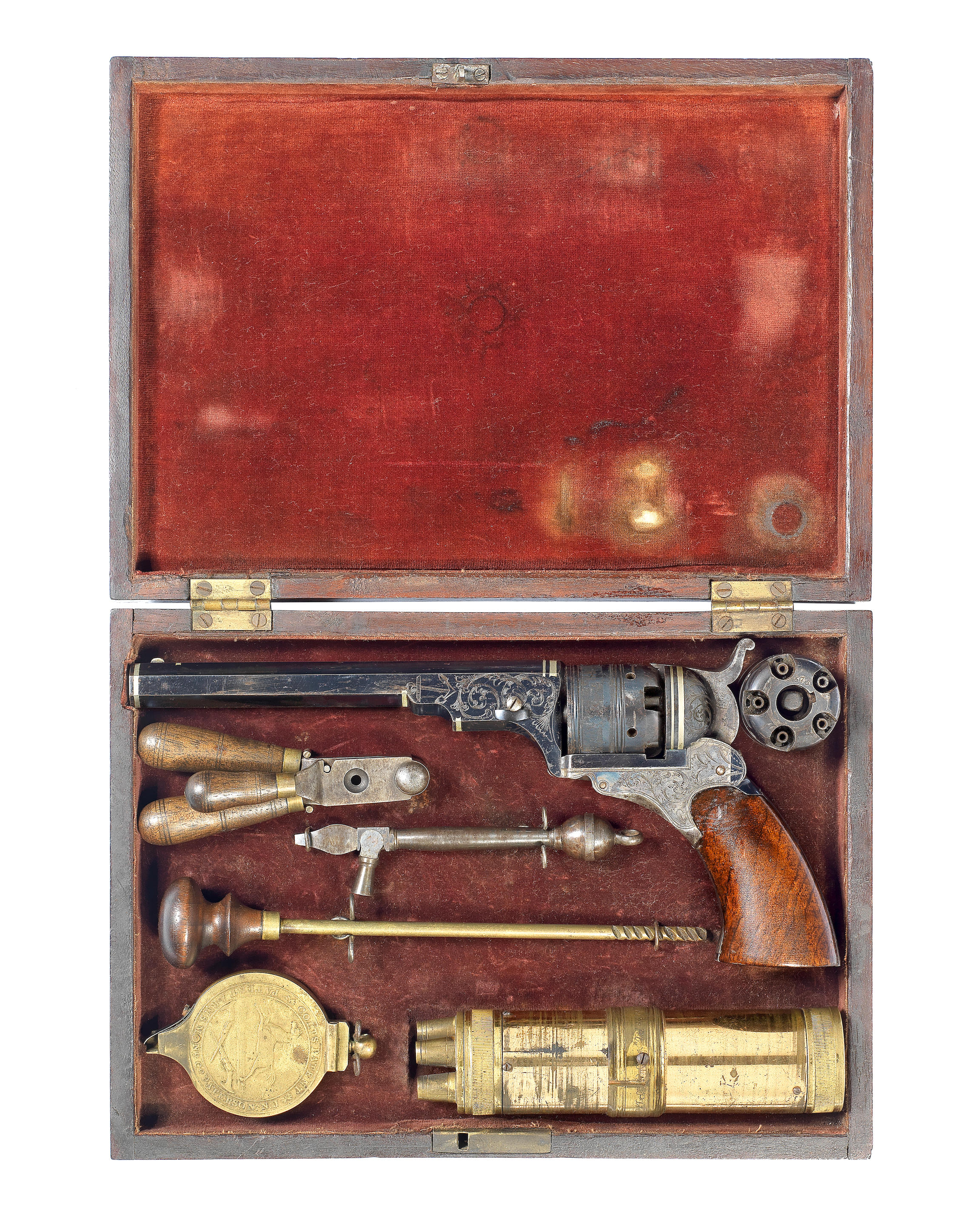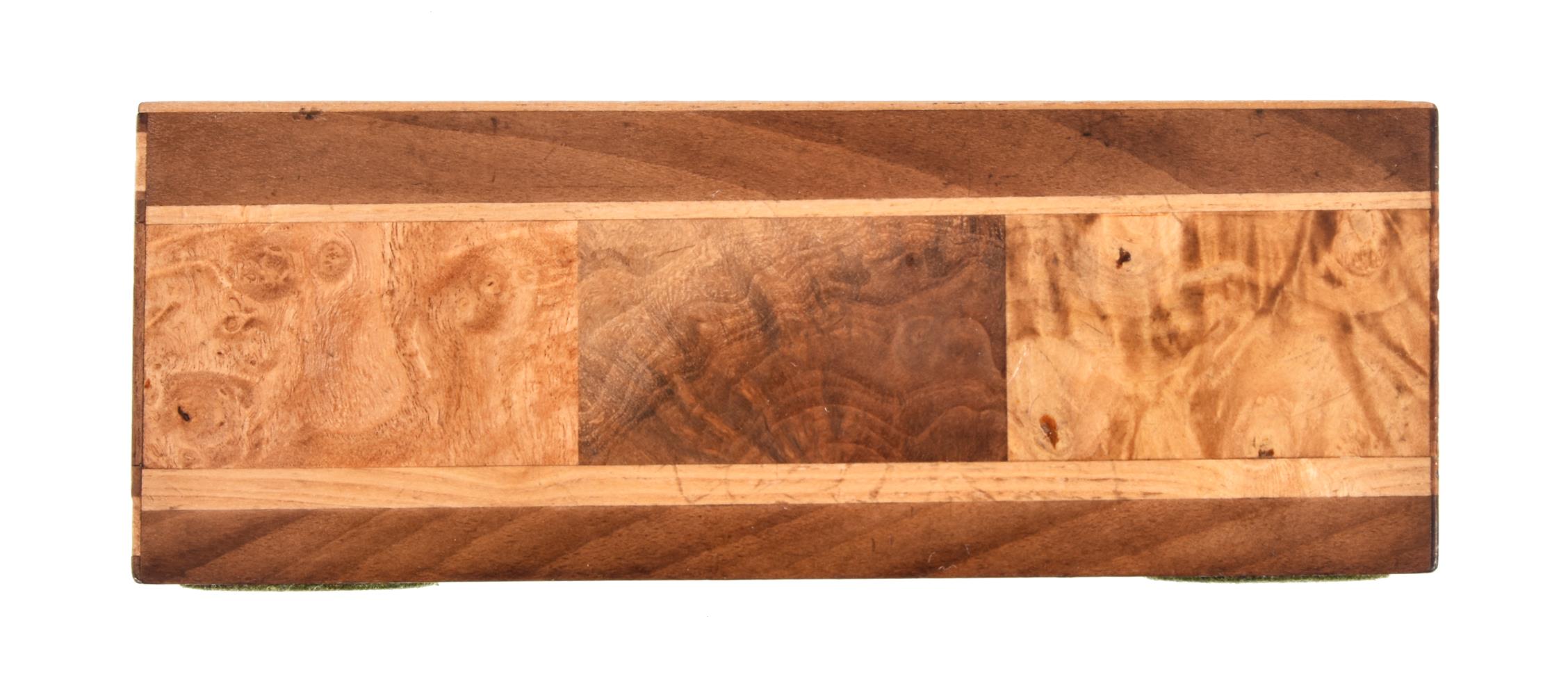A rare German mahogany wall regulator with electric rementoire Chronos to a design by Dr. Herman Aron, probably Schweidnitz, Silesia, circa 1890 The four pillar single train timepiece movement with small spring-box to the greatwheel arbor and deadbeat escapement regulated by wood-rod pendulum with brass lenticular bob, the tapered backplate stamped PATENT over number 290 and fitted with bevel gear to the great-wheel arbor to facilitate torque to be delivered from the electric rementoire mechanism fitted to the case above, the latter with rotating electromagnetic armature and switch gear to allow periodic oscillation against a ratchet wheel fitted with maintaining power to compensate for loss of delivery whilst the armature is resetting, the movement fitted with 6.25 inch circular silvered Arabic numeral dial with subsidiary seconds dial and inscribed Chronos to centre, with blued steel hands and brass bezel, the interior of the case fitted with ceramic insulated coil power supply to the left hand side of movement and with enamel beat scale over brass plates inscribed No: 290, Electric: Clock, Dr. Aron’s System, for direct currents,200 Volt and REFERENCE No. W 433, the exterior with ceramic insulated electrical connection posts to top over cavetto cornice and break-arch glazed full-height front door, the sides with slender windows over stepped ogee moulded base, 85cm (33.5ins) high. Hermann Aron was born in 1845 and in 1867 went to study Medicine at Berlin University before transferring to mathematics and natural sciences. From 1870 he studied at the University of Heidelberg with such notable physics lecturers as Helmholtz and Kirchhoff. He obtained his doctorate from Berlin in 1873 and became an assistant at the physical laboratory of the trade academy. He taught at the University of Berlin where he became professor of physics, and at the Prussian Army's school for artillery and engineers. In 1883 Dr. Hermann Aron patented the ‘Pendelzähler’ - the first accurate watt-hour meter. The meter contained two pendulum clocks with coils around their pendulum bobs. One was accelerated and the other slowed in proportion to the current used. A differential gear mechanism measured the difference in speed between the two clocks and counted this on a series of dials. The first meters used clockwork clocks that required manual winding monthly; later models were self-winding by electricity. This meter was introduced into Great Britain by Hugo Hirst and was made and sold by his General Electric Company from 1888. Aron also invented another called the 'Aronschaltung' comprising a circuit for measuring total power in three-phase AC circuits, whilst requiring only two direct measurements of power. These inventions expanded into a business with factories in Paris (1890), London (1893), Vienna (1897) and By the time of his death in 1913, it employed over 1,000 people. The electric winding system (or rementoire) used in the current lot is basically the same as used in Aron’s electricity meters as sold by G.E.C.; a detailed description and illustrations of its operation can be found in Wise, S.J. ELECTRIC CLOCKS, Principles, Construction, Operation, Installation and Repair of Mains and Battery-operated Clocks for Domestic and Industrial Purpose on pages 61-2 (Figures 31-33).
A rare German mahogany wall regulator with electric rementoire Chronos to a design by Dr. Herman Aron, probably Schweidnitz, Silesia, circa 1890 The four pillar single train timepiece movement with small spring-box to the greatwheel arbor and deadbeat escapement regulated by wood-rod pendulum with brass lenticular bob, the tapered backplate stamped PATENT over number 290 and fitted with bevel gear to the great-wheel arbor to facilitate torque to be delivered from the electric rementoire mechanism fitted to the case above, the latter with rotating electromagnetic armature and switch gear to allow periodic oscillation against a ratchet wheel fitted with maintaining power to compensate for loss of delivery whilst the armature is resetting, the movement fitted with 6.25 inch circular silvered Arabic numeral dial with subsidiary seconds dial and inscribed Chronos to centre, with blued steel hands and brass bezel, the interior of the case fitted with ceramic insulated coil power supply to the left hand side of movement and with enamel beat scale over brass plates inscribed No: 290, Electric: Clock, Dr. Aron’s System, for direct currents,200 Volt and REFERENCE No. W 433, the exterior with ceramic insulated electrical connection posts to top over cavetto cornice and break-arch glazed full-height front door, the sides with slender windows over stepped ogee moulded base, 85cm (33.5ins) high. Hermann Aron was born in 1845 and in 1867 went to study Medicine at Berlin University before transferring to mathematics and natural sciences. From 1870 he studied at the University of Heidelberg with such notable physics lecturers as Helmholtz and Kirchhoff. He obtained his doctorate from Berlin in 1873 and became an assistant at the physical laboratory of the trade academy. He taught at the University of Berlin where he became professor of physics, and at the Prussian Army's school for artillery and engineers. In 1883 Dr. Hermann Aron patented the ‘Pendelzähler’ - the first accurate watt-hour meter. The meter contained two pendulum clocks with coils around their pendulum bobs. One was accelerated and the other slowed in proportion to the current used. A differential gear mechanism measured the difference in speed between the two clocks and counted this on a series of dials. The first meters used clockwork clocks that required manual winding monthly; later models were self-winding by electricity. This meter was introduced into Great Britain by Hugo Hirst and was made and sold by his General Electric Company from 1888. Aron also invented another called the 'Aronschaltung' comprising a circuit for measuring total power in three-phase AC circuits, whilst requiring only two direct measurements of power. These inventions expanded into a business with factories in Paris (1890), London (1893), Vienna (1897) and By the time of his death in 1913, it employed over 1,000 people. The electric winding system (or rementoire) used in the current lot is basically the same as used in Aron’s electricity meters as sold by G.E.C.; a detailed description and illustrations of its operation can be found in Wise, S.J. ELECTRIC CLOCKS, Principles, Construction, Operation, Installation and Repair of Mains and Battery-operated Clocks for Domestic and Industrial Purpose on pages 61-2 (Figures 31-33).













Testen Sie LotSearch und seine Premium-Features 7 Tage - ohne Kosten!
Lassen Sie sich automatisch über neue Objekte in kommenden Auktionen benachrichtigen.
Suchauftrag anlegen